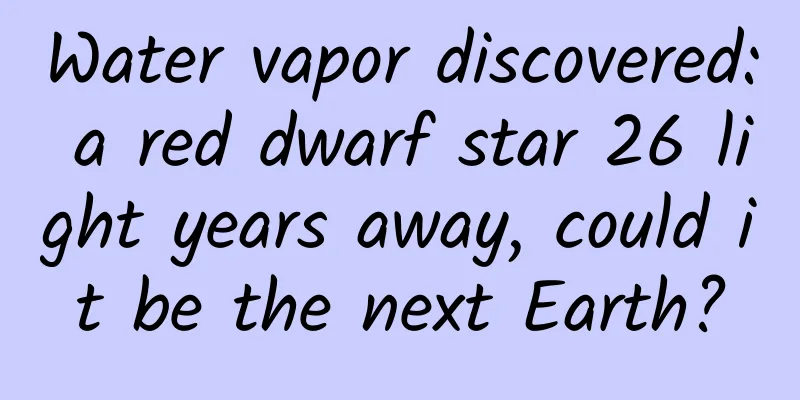Water vapor discovered: a red dwarf star 26 light years away, could it be the next Earth?

|
Webb telescope finds exoplanet with near-Earth water vapor Artist's conception of GJ 486 b, a rocky exoplanet orbiting a red dwarf star 26 light-years from Earth. NASA's Webb Space Telescope has found weak evidence for water vapor on the planet, but we still don't know if it's in the planet's atmosphere or in starspots. Image via NASA/ ESA/ CSA/ Joseph Olmsted (STScI)/ Leah Hustak (STScI). Astronomers can prove the presence of water vapor in the atmospheres of many exoplanets. So far, the planets discovered are much larger than the Earth, such as gas dwarfs and super-Jupiters. But what about the slightly smaller, Earth-sized terrestrial planets? Because of the distance, it is difficult for us to detect water vapor on these relatively small planets. However, on May 1, 2023, researchers from the United Kingdom and the United States reported that they had found water vapor in the atmospheres of terrestrial planets and red dwarf stars orbiting them. Astronomers used the Webb Space Telescope to conduct this observational study 26 light-years away. A draft of a related new paper published by the researchers on April 10, 2023, has been accepted for publication in the Astrophysical Journal Letters. Webb telescope detects water vapor GJ 486 b is a terrestrial planet that is 1.3 times the size of Earth and 3 times its mass. This makes astronomers call it a super-Earth. Its orbit is so close to that of its star that it only takes 1.5 days to complete one orbit. Therefore, unfortunately, scientists estimate that its temperature is as high as 800 degrees Fahrenheit (430 degrees Celsius), which makes it seem unsuitable for any life. Scientists have found that it seems to be tidally locked, so that it always faces the same side towards its star. Despite these high temperatures, water vapor could still be present in GJ 486 b's atmosphere, provided the planet has an atmosphere, which is still uncertain. However, Webb's observations did show traces of water vapor, which was already exciting. Does (water vapor) exist on the planet or on its star? The big question is: Does the water vapor exist on the planet, or is it actually on its star? The lead author from the University of Arizona commented: "We found definite traces that only water could leave. But we can't be sure that the water came from the planet's atmosphere, or whether the planet has an atmosphere, and the evidence for water actually came from the star." Kevin Stevenson from Johns Hopkins University added: "The discovery of water vapor on a hot Earth-like planet would be a major breakthrough in exoplanet science. But we have to rule out the possibility of interference from the star." Planetary transits provide us with evidence So how did scientists detect water vapor? Webb observed GJ 486 b as it passed by its star, as seen from Earth. And it did so not just once, but twice. Each transit lasted about an hour. The researchers used three techniques to analyze the data. Interestingly, all three methods yielded similar results, with the transmission spectra from planets and stars being mostly flat. However, there was a sudden increase in the region of the spectrum for the shortest infrared light. So what caused this increase? Which atoms did the scientists find to be responsible? To investigate, the researchers hypothesized models in a computer using different atoms. It turned out that the best explanation for this observation was water vapor. GJ 486 b's emission spectrum suggests the presence of water vapor. The graph above compares two models for where the water vapor might be located: in the atmosphere or in starspots. Image credit: NASA/ ESA/ CSA/ Joseph Olmsted (STScI)/ Sarah E. Moran (University of Arizona)/ Kevin B. Stevenson (APL)/ Ryan MacDonald (University of Michigan)/ Jacob A. Lustig-Yaeger (APL). Water vapor exists in starspots? If water vapor doesn't exist in the atmospheres of planets, then it exists in starspots on red dwarfs, dark spots on the surface of stars that are like sunspots on our sun. Is this possible? Incredibly, water vapor can exist in starspots because the temperature in starspots is much lower than the temperature of the surrounding sun's surface. The researchers believe that because the temperature of GJ 486 b's star is already much lower than our sun, the temperature in its starspots would be much lower than that of sunspots. Therefore, the starspots of this star can store even more water vapor. If a planet passes through a starspot during its transit, this phenomenon would make the water vapor in the starspots look like it exists on the planet. This is a theory worthy of applause, although there is still a problem that scientists have never observed a planet transiting before a starspot. But it is also possible that there are starspots that astronomers have not yet seen. "We still haven't seen a planet transit in front of a starspot," said co-authors from the University of Michigan. "But that doesn't mean there aren't other starspots on the star, and that the physics of this could cause water molecules to end up looking like they're in the atmosphere." More and deeper observations are needed Today, it is still unclear whether the source of the water vapor is a planet or a star. Researchers say they still need to conduct more observations with the two components of the Webb telescope to determine the true source of the water vapor. The mid-infrared instrument (MIRI) will observe the sunward side of the planet. If the planet has no atmosphere, or a very thin atmosphere, the hottest areas on the sunward side of the planet will be facing the star. At the same time, if the hottest areas move, this phenomenon will indicate the presence of an atmosphere that can circulate heat. In addition, the Near Infrared Imaging and Slitless Spectroscopy Instrument (NIRISS) can distinguish whether the phenomenon is caused by the planet's atmosphere or starspots. But only the combination of a series of instruments can finally give a conclusion on whether there is water vapor on GJ 486 b. As Stevenson points out: It will take a combination of instruments to really determine whether a planet has an atmosphere. In 2019, astronomers reported finding water vapor in the atmosphere of another super-Earth, K2-18b. The planet was once considered habitable. Later, researchers said that the planet was more like a gas dwarf with a thick atmosphere composed of hydrogen and probably no solid surface. BY:Paul Scott Anderson FY: Hu Yushu If there is any infringement of related content, please contact the author to delete it after the work is published. Please obtain authorization for reprinting, and pay attention to maintaining integrity and indicating the source |
<<: How to identify an AI bird photo? It is recommended to learn some bird guides first
Recommend
What are the writing techniques for creative titles of Baidu promotion bidding?
How to write advertising creatives for Baidu prom...
11 ways to increase product conversion rate!
Improving conversion rate is one of the core task...
Real Physics Terms: Microscopic Particles in Quantum Physics
When creating proper nouns, one principle is to r...
Mini Program Enterprise Entity Migration, How to Change the Entity of WeChat Mini Program?
Mini Program Enterprise Entity Migration, How to ...
Avoid lightning! This is the seat where you feel the most turbulence in an airplane
Review expert: Zhao Liangyu, Associate Professor,...
"Is there anything that can't be discussed after the New Year?" These things can't be discussed!
The New Year is coming soon, and people often say...
Android Study: findViewById's evolution
Preface Today we will talk about findViewById, wh...
How to do a good job of Zhihu marketing for a brand?
Zhihu's commercial marketing system is curren...
If Loulan and this car are combined, Highlander will have to give way to the wise.
In the SUV market segment, Nissan's performan...
42 marketing tips hidden by marketers!
Marketing guru Ted Levitt once said: There is no ...
How to operate and grow a product from 0 to 1?
A few days ago, I met a new entrepreneur who is e...
A heart-breaking suggestion for advertising purchased with a 1 million yuan budget!
People often ask me, which channel is the most ef...
Which one has better optical image stabilization? iPhone 6 Plus vs Note 4
Optical image stabilization is now common in smar...
A complete guide to information flow optimization. Are you still worried about conversion after reading this?
Conversion is the core of bidders, so what is the...









